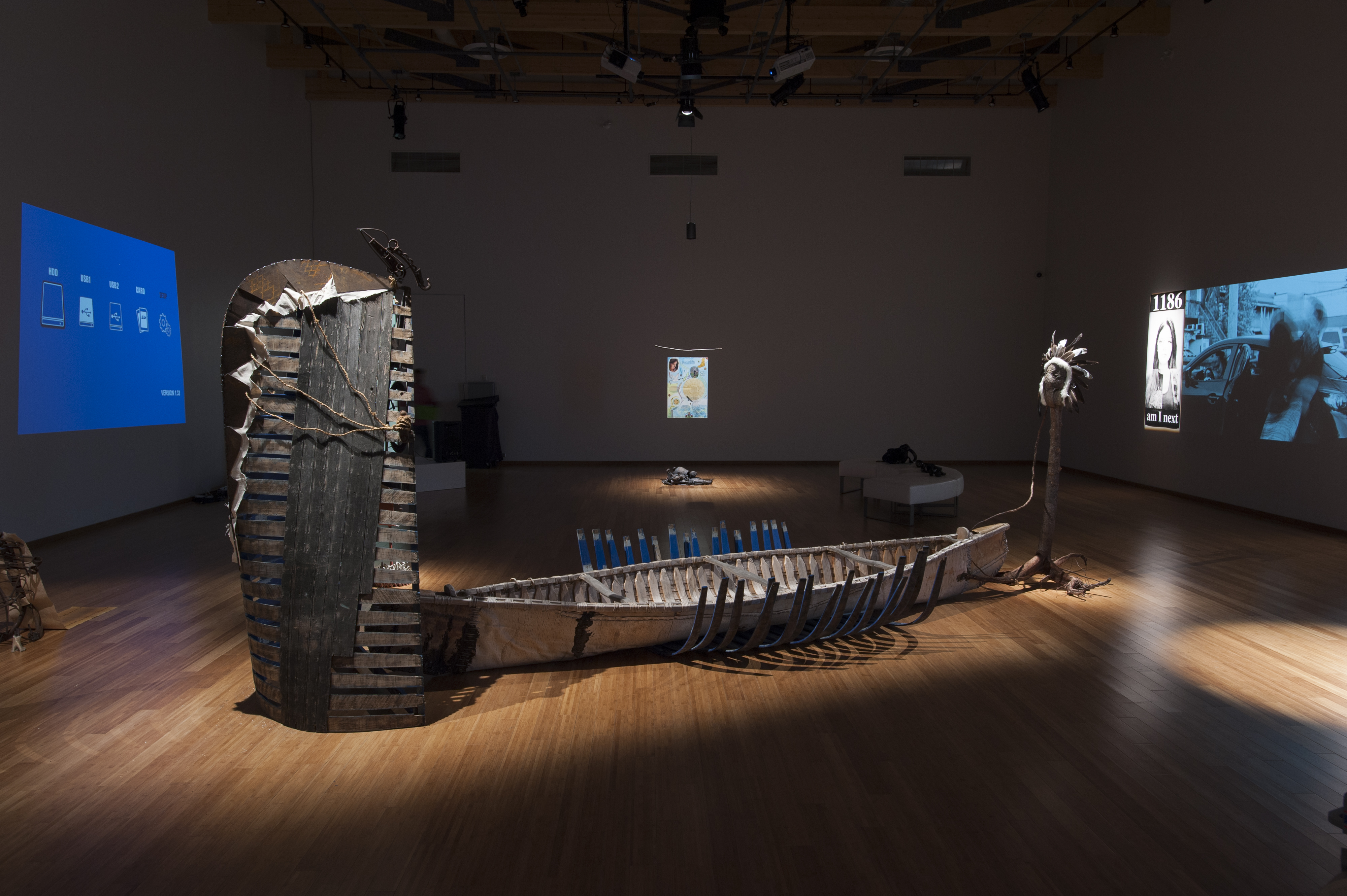Nous avons besoin d’une nouvelle histoire : la marche et l’imagination wâhkôhtowin
DOI :
https://doi.org/10.25071/1916-4467.40873Mots-clés :
l'Histoire, marcher, wâhkôhtowin, la relation de parentéRésumé
Nous offrons ici une traduction de l’article anglais, originalement intitulée We Need a New Story: Walking and thewâhkôhtowin Imagination. Inspiré et guidé par le concept de sagesse nêhiyaw de wâhkôhtowin, cet article présente la marche comme une pratique de vie qui peut enseigner la relation de parenté et aider à reconceptualiser les relations entre les Autochtones et le Canada en fonction de modalités plus éthiques. Je soutiens qu'aujourd'hui, les relations entre les Autochtones et les Canadiens continuent d'être fortement influencées par les enseignements coloniaux, qui mettent l'accent sur le déni des relations. Les éducateurs au Canada aujourd'hui font face au défi scolaire important de parvenir à faciliter l'émergence d'un nouveau récit qui peut réparer les fractures coloniales héritées et donner de bonnes indications sur la façon dont les Peuples autochtones et les Canadiens peuvent vivre leurs rapports ensemble différemment. D'après mon expérience, l'émergence d'une nouvelle histoire peut être facilitée par la marche comme pratique de vie.
Références
Blaut, J. (1993). The colonizer’s model of the world: Geographical diffusionism and Eurocentric history. Guilford Press.
Campbell, M. (2007, November). We need to return to the principles of Oaktown. Eagle Feather News, 10(11), 5. https://www.eaglefeathernews.com/quadrant/media/pastIssues/November_2007.pdf
Casey, E. (1997). The fate of place: A philosophical history. University of California Press.
Chambers, C. (2008). Where are we? Finding common ground in a curriculum of place. Journal of the Canadian Association for Curriculum Studies, 6(2), 113-128. https://jcacs.journals.yorku.ca/index.php/jcacs/article/view/18099
Darling-Hammond, L. (2010). Teaching and educational transformation. Dans A. Hargreaves, A. Lieberman, M. Fullan et D. Hopkins (dir.), Second international handbook of educational change (p. 505-520). Springer. DOI: https://doi.org/10.1007/978-90-481-2660-6_30
Donald, D. (2019) Homo economicus and forgetful curriculum. Dans H. Tomlinson-Jahnke, S. Styres, S. Lille et D. Zinga (dir.), Indigenous education: New directions in theory and practice (p. 103-125). University of Alberta Press. DOI: https://doi.org/10.1515/9781772124477-007
Donald, D. (2021). We need a new story: Walking and the wâhkôhtowin imagination. Journal of the Canadian Association for Curriculum Studies, 18(2), 53 63. https://doi.org/10.25071/1916-4467.40492 DOI: https://doi.org/10.25071/1916-4467.40492
Gatschet, A. S. (1899). " Real," true," or "genuine," in Indian languages. American Anthropologist, 1(1), 155-161. https://www.jstor.org/stable/i227138 DOI: https://doi.org/10.1525/aa.1899.1.1.02a00110
Ingold, T. (2004). Culture on the ground: The world perceived through the feet. Journal of Material Culture, 9(3), 315-340. https://doi.org/10.1177/1359183504046896 DOI: https://doi.org/10.1177/1359183504046896
Ingold, T. (2010). Footprints through the weather‐world: Walking, breathing, knowing. Journal of the Royal Anthropological Institute, 16, S121-S139. https://doi.org/10.1111/j.1467-9655.2010.01613.x DOI: https://doi.org/10.1111/j.1467-9655.2010.01613.x
Ingold, T., et Vergunst, J. L. (dir.). (2008). Ways of walking: Ethnography and practice on foot. Ashgate.
Kincheloe, J. L. (2000). Cultural studies and democratically aware teacher education: Post-Fordism, civics and the worker-citizen. Dans D. W. Hursh et E. W. Ross (dir.), Democratic social education: Social studies for social change (p. 97-120). Falmer Press. https://www-taylorfrancis-com.proxy.bib.uottawa.ca/books/edit/10.4324/9781315054278/democratic-social-education-david-hursh-wayne-ross
Lowe, L. (2015). The intimacies of four continents. Duke University Press. DOI: https://doi.org/10.1515/9780822375647
Macauley, D. (2001). Walking the elemental earth: Phenomenological and literary “foot notes”. Dans A. T. Tymieniecka (dir.), Passions of the earth in human existence, creativity, and literature (p. 15-31). Springer. DOI: https://doi.org/10.1007/978-94-010-0930-0_2
Nisbet, R. A. (1980). History of the idea of progress. Basic Books.
Praet, I. (2013). Humanity and life as the perpetual maintenance of specific efforts: A reappraisal of animism. Dans T. Ingold et G. Palsson (dir.), Biosocial becomings: Integrating social and biological anthropology (p. 191-210). Cambridge University Press. DOI: https://doi.org/10.1017/CBO9781139198394.011
Sheller, M. et Urry, J. (2006). The new mobilities paradigm. Environment and Planning A: Economy and Space, 38(2), 207-226. https://doi.org/10.1068/a37268 DOI: https://doi.org/10.1068/a37268
Solnit, R. (2001). Wanderlust: A history of walking. Penguin.
Somerville, M., Tobin, L.et Tobin, J. (2019). Walking contemporary Indigenous songlines as public pedagogies of country. Journal of Public Pedagogies: WalkingLab, 4, 13-27. https://doi.org/10.15209/jpp.1171 DOI: https://doi.org/10.15209/jpp.1171
Tenner, E. (1997). How the chair conquered the world. Wilson Quarterly, 21(2), 64-70. http://archive.wilsonquarterly.com/essays/how-chair-conquered-world
Van Essen, A. (2018). Bending, turning, and growing: Cree language, laws, and ceremony in Louise B. Halfe/Sky Dancer's The Crooked Good. Studies in American Indian Literatures, 30(1), 71-93. https://doi.org/10.5250/studamerindilite.30.1.0071 DOI: https://doi.org/10.5250/studamerindilite.30.1.0071
Willinsky, J. (1994). After 1492-1992: A post-colonial supplement for the Canadian curriculum. Journal of Curriculum Studies, 26(6), 613-629. https://doi.org/10.1080/0022027940260603 DOI: https://doi.org/10.1080/0022027940260603
Wynter, S. (1995). 1492: A new world view. Dans V. L. Hyatt et R. Nettleford (dir.), Race, discourse, and the origin of the Americas: A new world view (p. 5-57). Smithsonian Institution Press.
Téléchargements
Publié-e
Comment citer
Numéro
Rubrique
Licence
© Dwayne Donald; Diane Campeau 2023 
Copyright for work published in JCACS belongs to the authors. All work is licensed under a Creative Commons Attribution-ShareAlike 4.0 International license.


